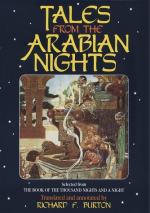[FN#185] This is true Orientalism, a personification or incarnation which Galland did not think proper to translate.
[FN#186] Arab. “La’ab al-Andab;” the latter word is from “Nadb” = brandishing or throwing the javelin.
[FN#187] The “mothers” are the prime figures, the daughters being the secondary. For the " ’Ilm al-Ram!” = (Science of the sand) our geomancy, see vol. iii. 269, and D’Herbelot’s sub. v. Raml or Reml.
[FN#188] This is from Galland, whose certaine boisson chaude evidently means tea. It is preserved in the H.V.
[FN#189] i.e. his astrolabe, his “Zij” or table of the stars, his almanack, etc. For a highly fanciful derivation of the “Arstable” see Ibn Khallikan (iii. 580). He makes it signify “balance or lines (Pers. ‘Astur’) of the sun,” which is called “Lab” as in the case of wicked Queen Lab (The Nights, vol. vii. 296). According to him the Astrolabe was suggested to Ptolemy by an armillary sphere which had accidentally been flattened by the hoof of his beast: this is beginning late in the day, the instrument was known to the ancient Assyrians. Chardin (Voyages ii. 149) carefully describes the Persian variety of—
“The cunning man highs Sidrophil
(as Will. Lilly was called). Amongst other things he wore at his girdle an astrolabe not bigger than the hollow of a man’s hand, often two to three inches in diameter and looking at a distance like a medal.” These men practiced both natural astrology = astronomy, as well as judicial astrology which foretells events and of which Kepler said that “she, albeit a fool, was the daughter of a wise mother, to whose support and life the silly maid was indispensable.” Isidore of Seville (A. D. 600-636) was the first to distinguish between the two branches, and they flourished side by side till Newton’s day. Hence the many astrological terms in our tongue, e.g. consider, contemplate, disaster, jovial, mercurial, saturnine, etc.
[FN#190] In the H. V. “New brass lamps for old ones! who will exchange ?” So in the story of the Fisherman’s son, a Jew who had been tricked of a cock, offers to give new rings for old rings. See Jonathan Scott’s excerpts from the Wortley-Montague MSS. vol. vi. pp. 210 12 This is one of the tales which I have translated for vol. iv.
[FN#191] The H. V. adds that Alaeddin loved to ride out a-hunting and had left the city for eight days whereof three had passed by.
[FN#192] Galland makes her say, He bien folle, veux-tu me dire pourqoui tu ris? The H. V. renders “Cease, giddy head, why laughest thou?” and the vulgate “Well, giggler,” said the Princess, etc.
[FN#193] Nothing can be more improbable than this detail, but upon such abnormal situations almost all stones, even in our most modern “Society-novels,” depend and the cause is clear—without them there would be no story. And the modern will, perhaps, suggest that “the truth was withheld for a higher purpose, for the working out of certain ends.” In the H. V Alaeddin, when about to go a-hunting, always placed the Lamp high up on the cornice with all care lest any touch it.




